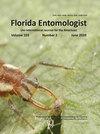Cultural Control of Giant Sugarcane Borer, Telchin licus (Lepidoptera: Castniidae), by Soil Mounding to Impede Adult Emergence
IF 1.2
4区 农林科学
Q3 ENTOMOLOGY
引用次数: 2
Abstract
Abstract The giant sugarcane borer, Telchin licus (Drury) (Lepidoptera: Castniidae), also known as the banana stem borer, is an economically important pest of sugarcane in eastern Colombia. The presence of larval and pupal stages within stalks makes biological control of this pest difficult, and growers often resort to insecticide applications. Hilling up the soil around the base of plants, or soil mounding, is a cultural practice sometimes used to improve rooting in sugarcane. Because mature larvae cut holes in stalks close to ground level through which they can emerge as an adult, we hypothesized that soil mounding would impede adult emergence, and thus contribute to population reduction. Two experiments were conducted in fields with significant infestations of this pest in Puerto López, Meta, Colombia, during the seasons of adult emergence in this region (Apr–May and Oct–Nov). Manual mounding of soil to a height of 20 cm was tested in the first trial, and mechanized mounding of soil in the second, which also compared 2 mounding heights (10 and 20 cm). In both cases, 2 m row transects of plants were caged to collect emergent adults. Adult emergence was reduced up to 65% in all mounding treatments, whether manual or mechanical, and regardless of mounding height, demonstrating that this cultural practice could be a useful tactic for inclusion in an integrated management program for this pest. However, as with any other cultural practice in pest management, region-wide implementation likely would be required to impact local population densities, and efficacy will depend further on low levels of moth immigration from alternative host plants.用土堆法防治大型甘蔗螟Telchin licus(鳞翅目:甘蔗科)
摘要巨大的甘蔗蛀虫Telchin licus(Drury)(鳞翅目:甘蔗科),也称为香蕉茎蛀虫,是哥伦比亚东部甘蔗的一种重要经济害虫。秸秆中幼虫和蛹阶段的存在使这种害虫的生物控制变得困难,种植者经常使用杀虫剂。将植物根部周围的土壤翻坡,或土壤翻丘,是一种文化实践,有时用于提高甘蔗的生根率。由于成熟的幼虫在接近地面的茎上挖洞,通过这些洞它们可以成年,我们假设土壤翻丘会阻碍成年的羽化,从而导致种群减少。在哥伦比亚梅塔的洛佩斯港,在该地区成虫出现的季节(4月至5月和10月至11月),在该害虫严重侵扰的田地里进行了两项实验。在第一次试验中,对20厘米高的土壤进行了人工翻堆,在第二次试验中对土壤进行了机械翻堆,还比较了2个翻堆高度(10和20厘米)。在这两种情况下,2米长的植物样带都被关在笼子里,以收集发芽的成虫。无论是手动还是机械的,无论丘的高度如何,在所有的丘处理中,成虫的羽化率都降低了65%,这表明这种培养方法可能是一种有用的策略,可以纳入这种害虫的综合管理计划。然而,与害虫管理中的任何其他文化实践一样,可能需要在全地区范围内实施,以影响当地的种群密度,其效果将进一步取决于来自替代寄主植物的蛾类迁移水平低。
本文章由计算机程序翻译,如有差异,请以英文原文为准。
求助全文
约1分钟内获得全文
求助全文
来源期刊

Florida Entomologist
生物-昆虫学
CiteScore
2.10
自引率
7.10%
发文量
44
审稿时长
3 months
期刊介绍:
Florida Entomologist is the official journal of the Florida Entomological Society. Volumes 1-3 were published under the name The Florida Buggist. The Florida Entomological Society still produces the traditionally printed version of Florida Entomologist, but you can also view, search, or print any article published since June 1917 by accessing online files. Web access is made possible by the Society’s electronic publication project begun in 1993
 求助内容:
求助内容: 应助结果提醒方式:
应助结果提醒方式:


